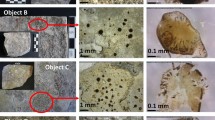Abstract
An automatic system for marine meiobenthos separation was developed by using laser-induced fluorescence technology. Rose Bengal was used as organism dye and the spectrums of Rose Bengal were measured. Laser-induced fluorescence system was established to detect marine meiobenthos in sediments. Data obtained from experiments were analyzed by using a mathematical model. The results showed that laser-induced fluorescence technology worked well in the system. The system could select the meiobenthos efficiently and precisely.
Similar content being viewed by others
References
Chuck, R.S., Arnoldussen, M.E., Behrens, A., 2002. Fluorescence-guided laser removal of chemicaly damaged cornea.Journal of Cataract & Refractive Surgery,28(10):1847–1852.
De Jonge, V.N., Bouwman, L.A., 1977. A simple density separation technique for quantitative isolation of meiobenthos using the colloidal silica Ludox-TM.Marine Biology,42(2):143–148.
Dillon, W.P., 1964. Flotation technique for separating fecal pellets and small marine organisms from scand.Limnology and oceanography,9:601–602.
Gwyther, D., 2004. Impact of the deposition of jarosite on deepwater meiobenthos in southeastern.Australia Marine Pollution Bulletin,48(9–10):997–1003.
Heip, C., Smol, N., Hautekiet, W., 1974. A rapid method for extracting meiobenthic Nematodes and Copepods from mud and detritus.Marine Biology,28:79–81.
Jensen, P., 1982. A new meiofauna sample splitter.Annales Zoologici Fennici,19:233–236.
Kitazato, H., Nakatsuka, T., Shimanaga, M., Kanda, J., Soh, W., Kato, Y., Okada, Y., Yamaoka, A., Masuzawa, T., Suzuki, K., Shirayama, Y., 2003. Long-term monitoring of the sedimentary processes in the central part of Sagami Bay, Japan: Rationale, logistics and overview of results.Progress In Oceanography,57(1):3–16.
Kopp, M.U., Crabtree, H.J., Manz, A., 1997. Developments in technology and applications of Microsystems.Current Opinion in Chemical Biology,1(3):410–419.
Larkin, J.M., Donaldson, W.R., Foster, T.H., Knox, R.S., 1999. Reverse intersystem crossing from a triplet state of rose Bengal populated by sequential 532 nm plus 1064 nm laser excitation.Chemical Physics,244:319–330.
Li, Y.B., Zhu, J., Yang, Y.L., Xu, J., Zhang, H.G., Shi, H.M., 1996. The establishment of laser-induce fluorescence detection system.Laser Medicine,6(3):97–102.
Lu, X., Huang, W.H., Wang, Z.L., Cheng, J.K., 2004. Recent developments in single-cell analysis.Analytica Chimica Acta,510(2):127–138.
Mclntyre, A.D., 1969. Ecology of marine meiobenthos.Biological Reviews,44:245–290.
Michael, A., Daniel, R., Armstrong, W., 2004. Separation and analysis of colloidal/nano-particles including microoranisms by capillary electrophoresis: A fundamental review.Journal of Chromatography B,800(1–2):7–25.
Nichols, J.A., 1979. A simple flotation technique for separation meiobenthic nematodes from fine-grained sediments.Trasactions of American Microscopical Society,98: 127–130.
Schwinghamer, P., 1981. Extraction of living meiofauna from marine sediments by centrifugation in a silica Sol-Sorbitol mixture.Canadian Journal of Fisheries and Aquatic Sciences,38:476–478.
Author information
Authors and Affiliations
Additional information
Project (Grant No. DY105-03-01-15) supported by “Tenth Five Year Plan of R & D of International Deep-Sea” of National Ocean Mineral Resources R & D Association, China
Rights and permissions
About this article
Cite this article
Ye, Sm., Gao, Sj., Pan, Y. et al. Automatic separation system for marine meiobenthos based on laser-induced fluorescence technology. J Zheijang Univ Sci B 6, 535–539 (2005). https://doi.org/10.1631/jzus.2005.B0535
Received:
Accepted:
Published:
Issue Date:
DOI: https://doi.org/10.1631/jzus.2005.B0535




